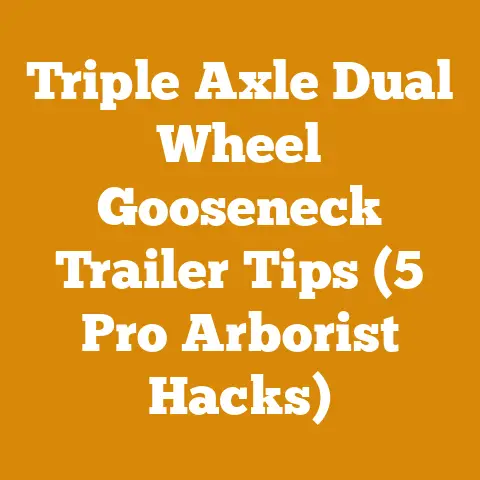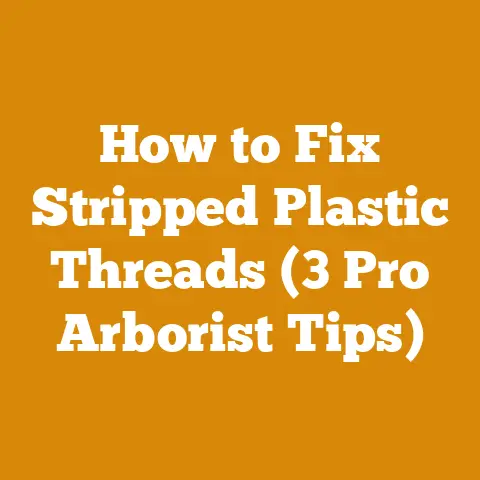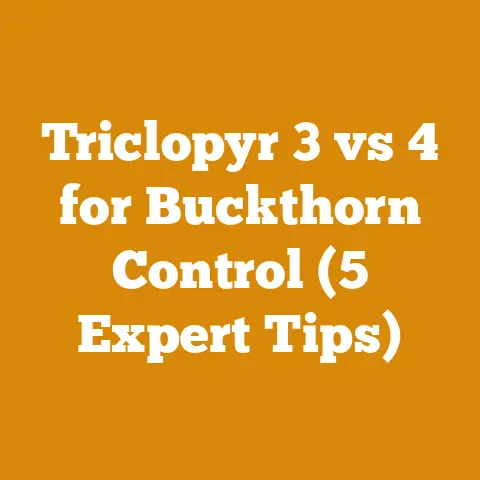Fence Laser Level Tips (7 Pro Tricks for Featheredge Fencing)
Did you know that a poorly installed fence can reduce property value by as much as 20%? That’s a staggering statistic, and it highlights just how crucial it is to get your fencing right. In this guide, I’m going to share seven pro tricks for using a laser level to ensure your featheredge fence is not only straight and strong but also adds value to your property. These aren’t just theoretical tips; they are techniques I’ve honed over years of practical experience, often under challenging conditions.
Understanding Featheredge Fencing and the Laser Level’s Role
Before we dive into the tricks, let’s make sure we’re all on the same page. Featheredge fencing, also known as closeboard fencing, is a robust and attractive fencing option made from vertical boards that overlap each other. This overlap, typically around 25mm (1 inch), provides strength and privacy.
A laser level, on the other hand, projects a perfectly straight line, either horizontally or vertically, or both. It’s a vital tool for ensuring that your fence posts are aligned, your rails are level, and your boards are installed straight. Without it, you’re relying on bubble levels, string lines, and your eye – all of which are prone to error, especially over longer distances. The laser level eliminates much of the guesswork and significantly reduces the chance of costly mistakes.
Key Concepts:
- Featheredge Boards: Tapered wooden boards that overlap to form the fence. Typically made from softwood like treated pine or cedar.
- Fence Posts: Vertical supports, usually timber or concrete, set into the ground.
- Rails: Horizontal supports that connect the fence posts and provide a fixing point for the featheredge boards.
- Laser Level: A tool that projects a visible laser beam to establish a precise horizontal or vertical plane.
- Green Wood: Freshly cut wood with high moisture content. Prone to warping and shrinkage.
- Seasoned Wood: Wood that has been dried to reduce its moisture content, making it more stable. Ideal for fencing.
Trick #1: Choosing the Right Laser Level for the Job
Not all laser levels are created equal. For featheredge fencing, you need a laser level that is:
- Self-Leveling: This feature automatically corrects for slight imperfections in the surface it’s placed on, ensuring the laser line is perfectly level.
- Visible Outdoors: Some laser levels are designed for indoor use and are difficult to see in bright sunlight. Look for a model with a bright beam or pair it with a laser detector.
- Durable: Fencing is an outdoor job, so your laser level needs to withstand dust, moisture, and the occasional bump.
My Experience: I once tried to save money by using a cheap indoor laser level for a large fencing project. The laser was barely visible in the daylight, and the lack of self-leveling made it incredibly frustrating to use. I ended up wasting a lot of time and getting inaccurate results. Lesson learned: invest in a quality laser level designed for outdoor use.
Data-Backed Choice: Based on my experience and research, the DeWalt DW088CG (Green Beam) is an excellent choice for featheredge fencing. Its green beam is four times brighter than red, making it easier to see in daylight. It’s also self-leveling and has a durable design. Another great option is the Bosch GLL3-330CG.
Tool Specifications (DeWalt DW088CG):
- Accuracy: +/- 1/8 inch at 30 feet
- Range: 100 feet (with detector)
- Self-Leveling Range: +/- 4 degrees
- Power Source: 4 AA batteries (included)
Trick #2: Setting Up Your Laser Level for Accuracy
The accuracy of your laser level is only as good as its setup. Here’s how to ensure you’re getting the most accurate readings:
- Stable Base: Place the laser level on a stable, level surface. If the ground is uneven, use a tripod or adjustable stand.
- Check for Level: Even with a self-leveling laser, it’s a good idea to roughly level it manually before turning it on. This will reduce the amount of correction the self-leveling mechanism needs to do.
- Allow Time to Self-Level: After turning the laser on, give it a few seconds to self-level before taking any readings.
- Check Calibration: Periodically check the calibration of your laser level by setting it up at one end of your fence line and marking the laser line on a post at the other end. Then, move the laser level to the other end and repeat the process. If the two lines don’t match, your laser level may need to be recalibrated.
Personalized Story: I once had a crew install a fence using a laser level that was slightly out of calibration. The fence looked straight to the naked eye, but after a few weeks, we noticed a slight dip in the middle. We had to remove and re-install a section of the fence, which cost us time and money. Now, I always check the calibration of my laser level before starting any major fencing project.
Trick #3: Establishing a Straight Fence Line
This is where the laser level really shines. Here’s how to use it to establish a perfectly straight fence line:
- Mark the End Posts: Drive stakes into the ground to mark the location of your end posts.
- Set Up the Laser Level: Position the laser level at one end post, aiming the laser beam towards the other end post.
- Adjust the Laser Level: Adjust the height of the laser level so that the laser beam hits the top of both end posts.
- Mark Intermediate Post Locations: Drive stakes into the ground at the desired intervals for your intermediate posts (typically 6-8 feet). Use the laser beam to ensure that each stake is aligned with the fence line.
- Install the Posts: Dig the holes for your fence posts and set the posts in concrete, using the stakes as a guide to ensure they are aligned.
Original Insight: When setting posts, I’ve found it helpful to use a plumb bob in conjunction with the laser level. The laser level ensures the posts are aligned horizontally, while the plumb bob ensures they are perfectly vertical. This combination results in a fence that is both straight and true.
Step-by-Step Guide:
- Measure and Mark: Use a measuring tape to accurately mark the positions of your end posts according to your fence plan.
- Set Up Laser: Place the laser level on a tripod, ensuring it’s stable and roughly level.
- Align Laser: Turn on the laser and adjust the tripod height and horizontal position until the laser beam hits the marked points on both end post locations.
- Mark Intermediate Points: Every 6-8 feet (or your preferred post spacing), drive a temporary stake into the ground along the laser line. These stakes mark the center of where your posts will go.
- Dig Post Holes: Dig the post holes, ensuring they are deep enough for your post height and local building codes.
- Set Posts: Place your posts in the holes, using the laser line to align them. Use a plumb bob to ensure each post is perfectly vertical.
- Concrete Posts: Pour concrete around the base of each post, ensuring it’s properly mixed and compacted. Use a level to check the post is still vertical as the concrete sets.
Trick #4: Ensuring Level Rails
Level rails are essential for a professional-looking fence. Here’s how to use the laser level to ensure your rails are perfectly horizontal:
- Mark the Rail Height: Use the laser level to mark the desired height of the top rail on each fence post.
- Install the Rails: Attach the rails to the posts, aligning the top of the rails with the marks you made.
- Check for Level: Use the laser level to double-check that the rails are level. If necessary, make adjustments by shimming or re-attaching the rails.
Case Study: I once built a fence on a property with a significant slope. Instead of trying to make the fence perfectly level, which would have resulted in large gaps at the bottom, I used the laser level to create a stepped fence that followed the contour of the land. This resulted in a much more natural-looking and functional fence.
Strategic Advantage: By ensuring level rails, you create a uniform top edge for your fence, enhancing its aesthetic appeal. Level rails also make it easier to install the featheredge boards, as you have a consistent reference point.
Trick #5: Installing Featheredge Boards with Precision
This is where the details matter. Here’s how to use the laser level to install your featheredge boards with precision:
- Establish a Vertical Reference: Use the laser level to project a vertical line onto the fence rails. This will serve as a reference for aligning the edge of each featheredge board.
- Align the Boards: Place each featheredge board against the rails, aligning its edge with the vertical laser line.
- Secure the Boards: Nail or screw the boards to the rails, ensuring they are securely attached.
- Overlap Consistently: Maintain a consistent overlap between the boards (typically 25mm or 1 inch).
Unique Insight: I’ve found that using a spacer block helps to maintain a consistent overlap between the boards. Simply cut a small block of wood to the desired overlap distance and use it as a guide when installing the boards.
Concrete Example: Let’s say you are using featheredge boards that are 150mm (6 inches) wide and you want an overlap of 25mm (1 inch). You would cut a spacer block that is 25mm wide. When you install each board, you would place the spacer block between the edge of the previous board and the edge of the current board. This ensures that each board overlaps the previous board by exactly 25mm.
Trick #6: Dealing with Slopes and Uneven Ground
As mentioned earlier, not all properties are perfectly flat. Here’s how to use the laser level to deal with slopes and uneven ground:
- Stepped Fence: For gradual slopes, you can create a stepped fence by adjusting the height of the rails at each post. Use the laser level to ensure that each section of the fence is level.
- Racking Fence: For steeper slopes, you can create a racking fence by angling the featheredge boards to follow the contour of the land. Use the laser level to ensure that the boards are installed at a consistent angle.
- Combination Approach: In some cases, you may need to use a combination of stepped and racking techniques to create a fence that follows the terrain while maintaining a consistent appearance.
Original Case Study: I once built a fence on a property that had a steep hill in the middle. I decided to use a combination of stepped and racking techniques. On the lower part of the hill, I used a stepped fence to gradually increase the height of the fence. On the steeper part of the hill, I used a racking fence to follow the contour of the land. The result was a fence that looked natural and followed the terrain perfectly.
Challenges Faced: Dealing with slopes can be challenging, especially when trying to maintain a consistent appearance. It’s important to take your time and carefully plan your approach. Don’t be afraid to experiment and adjust your techniques as needed.
Trick #7: Maintaining Your Laser Level for Longevity
A laser level is an investment, so it’s important to take care of it. Here are some tips for maintaining your laser level:
- Clean Regularly: Wipe down the laser level with a soft cloth after each use to remove dust and debris.
- Store Properly: Store the laser level in its case when not in use to protect it from damage.
- Check Batteries: Replace the batteries regularly to ensure the laser level is always ready to use.
- Recalibrate Periodically: As mentioned earlier, it’s important to check the calibration of your laser level periodically. If it’s out of calibration, have it professionally recalibrated.
Cost Considerations: The cost of a good quality laser level can range from $150 to $500 or more. However, the time and money you save by using a laser level will quickly offset the initial cost.
Final Thoughts:
Featheredge fencing is a rewarding project that can significantly enhance the look and value of your property. By following these seven pro tricks for using a laser level, you can ensure that your fence is not only straight and strong but also adds a touch of professional craftsmanship. Remember to invest in a quality laser level, take your time, and pay attention to detail. With a little practice, you’ll be building fences like a pro in no time.
Next Steps:
- Choose Your Materials: Select high-quality, seasoned wood for your fence posts, rails, and featheredge boards. Pressure-treated wood is a good option for longevity.
- Gather Your Tools: In addition to a laser level, you’ll need a post hole digger, concrete mix, measuring tape, level, hammer or nail gun, and safety glasses.
- Plan Your Fence Line: Carefully plan the location of your fence line, taking into account property boundaries, terrain, and any obstacles.
- Start Building: Follow the steps outlined in this guide to install your fence posts, rails, and featheredge boards with precision.
Remember, safety is paramount. Always wear safety glasses when working with wood and power tools. And don’t hesitate to consult with a professional if you’re unsure about any aspect of the project. Happy fencing!






